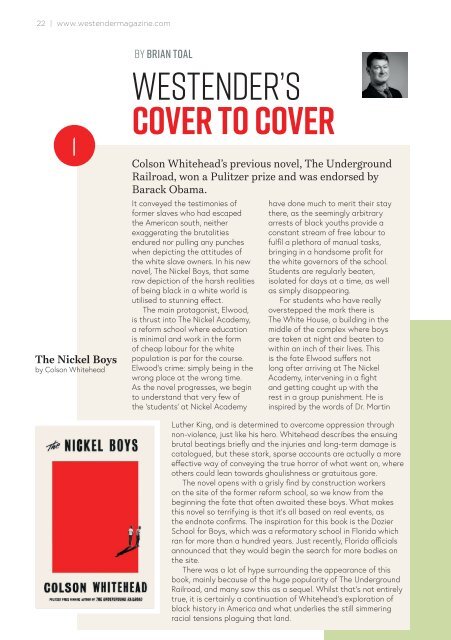November December 2019 Westender Magazine
Christmas 2019 Westender Magazine
Christmas 2019 Westender Magazine
Create successful ePaper yourself
Turn your PDF publications into a flip-book with our unique Google optimized e-Paper software.
22 | www.westendermagazine.com<br />
1<br />
The Nickel Boys<br />
by Colson Whitehead<br />
BY BRIAN TOAL<br />
WESTENDER’s<br />
COVER TO COVER<br />
Colson Whitehead’s previous novel, The Underground<br />
Railroad, won a Pulitzer prize and was endorsed by<br />
Barack Obama.<br />
It conveyed the testimonies of<br />
former slaves who had escaped<br />
the American south, neither<br />
exaggerating the brutalities<br />
endured nor pulling any punches<br />
when depicting the attitudes of<br />
the white slave owners. In his new<br />
novel, The Nickel Boys, that same<br />
raw depiction of the harsh realities<br />
of being black in a white world is<br />
utilised to stunning effect.<br />
The main protagonist, Elwood,<br />
is thrust into The Nickel Academy,<br />
a reform school where education<br />
is minimal and work in the form<br />
of cheap labour for the white<br />
population is par for the course.<br />
Elwood’s crime: simply being in the<br />
wrong place at the wrong time.<br />
As the novel progresses, we begin<br />
to understand that very few of<br />
the ‘students’ at Nickel Academy<br />
have done much to merit their stay<br />
there, as the seemingly arbitrary<br />
arrests of black youths provide a<br />
constant stream of free labour to<br />
fulfil a plethora of manual tasks,<br />
bringing in a handsome profit for<br />
the white governors of the school.<br />
Students are regularly beaten,<br />
isolated for days at a time, as well<br />
as simply disappearing.<br />
For students who have really<br />
overstepped the mark there is<br />
The White House, a building in the<br />
middle of the complex where boys<br />
are taken at night and beaten to<br />
within an inch of their lives. This<br />
is the fate Elwood suffers not<br />
long after arriving at The Nickel<br />
Academy, intervening in a fight<br />
and getting caught up with the<br />
rest in a group punishment. He is<br />
inspired by the words of Dr. Martin<br />
Luther King, and is determined to overcome oppression through<br />
non-violence, just like his hero. Whitehead describes the ensuing<br />
brutal beatings briefly and the injuries and long-term damage is<br />
catalogued, but these stark, sparse accounts are actually a more<br />
effective way of conveying the true horror of what went on, where<br />
others could lean towards ghoulishness or gratuitous gore.<br />
The novel opens with a grisly find by construction workers<br />
on the site of the former reform school, so we know from the<br />
beginning the fate that often awaited these boys. What makes<br />
this novel so terrifying is that it’s all based on real events, as<br />
the endnote confirms. The inspiration for this book is the Dozier<br />
School for Boys, which was a reformatory school in Florida which<br />
ran for more than a hundred years. Just recently, Florida officials<br />
announced that they would begin the search for more bodies on<br />
the site.<br />
There was a lot of hype surrounding the appearance of this<br />
book, mainly because of the huge popularity of The Underground<br />
Railroad, and many saw this as a sequel. Whilst that’s not entirely<br />
true, it is certainly a continuation of Whitehead’s exploration of<br />
black history in America and what underlies the still simmering<br />
racial tensions plaguing that land.














